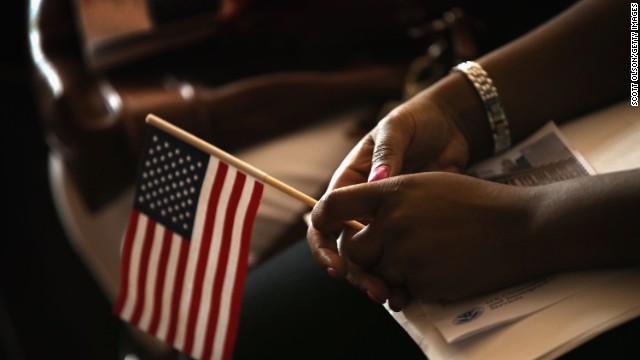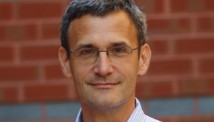- Back to Home »
- Your kids don't know their country

- Robert Pondiscio: Education reform is all about preparing kids for college and careers
- Pondiscio: But we need to teach how to be good citizens capable of running a democracy
- Constitution framers believed students must know civic rights and responsibilities, he says
- Pondiscio: Today, only one of five eighth-graders is proficient in civics and history
Editor's note: Robert Pondiscio is a former fifth grade teacher and the executive director of Citizenship First, a civic education organization based at Harlem's Democracy Prep Public Schools.
(CNN) -- When you're chowing down on hot dogs and hamburgers on this most patriotic of national holidays, try this experiment: Ask your friends and neighbors across the picnic table why they send their kids to school.
Chances are good that nearly everyone you ask will give an answer that reveals a private, dollars-and-cents view of education. We want to see our kids go to college, get good jobs, earn a decent living and make something of themselves.

We send our kids to school and hope they grow up to lead happy, productive lives, and with luck wind up a little better off than their parents. For most of us, education is the engine of upward mobility. These private aspirations are as American as apple pie.
But we send kids to school not just to become employees and entrepreneurs, but citizens capable of wise and effective self-government in our democracy. This public dimension of schooling was a founding principle of American education. We have all but forgotten it in the current era of education overhaul.
In order to become a naturalized U.S. citizen, you must pass an oral exam on history, civics and geography. Here are some of the hardest questions on the U.S. Citizenship Test -- and the percentage of Americans who know the correct answers.
1. When was the Constitution written?
A: 1787 (9%)
2. The House of Representatives has how many voting members?
A: 435 (16%)
3. What is the rule of law?
Government must obey the law; no one is above the law. (15%)
4. Name two rights in Declaration of Independence.
A: Life, liberty and the pursuit of happiness (18%)
5. Under the Constitution, some powers belong to the states. What is one power of the states?
Provide schooling and education; provide protection (police) and safety (fire departments) issue driver's licenses; and approve zoning and land use. (23%)
6. What does the judicial branch do?
Reviews or explains laws, resolves disputes, or decides if a law is unconstitutional (25%)
7. Who is the Chief Justice of the United States right now?
John Roberts (26%)
8. We elect a U.S. senator for how many years?
Six. (29%)
9. What is the supreme law of the land?
The U.S. Constitution. (29%)
10. How many justices are on the Supreme Court?
Nine. (32%)
This would strike our earliest thinkers about education as strange and foolish, even dangerous. Men like Benjamin Rush, Noah Webster and Horace Mann saw citizen-making as the most basic aim of education in our young nation. They understood that democracy is a historical long shot.
Every young student used to learn the famous story about Benjamin Franklin leaving the Constitutional Convention in 1787. A woman asked him what kind of government he and the other delegates had decided on. "A republic, madam -- if you can keep it," he replied.
Franklin and the framers of the Constitution knew republics had a nasty habit of being overwhelmed by factions and falling apart. Teaching children to understand, value and peaceably exercise their rights and responsibilities -- to keep the republic -- was indispensable to our democracy and could not be taken for granted. Where were those citizens, those "republican machines" in Benjamin Rush's phrase, to be created if not in our schools?
We've drifted a long way from this view of public education. We typically hear the performance of America's children in reading, math and science described as a crisis. But these are areas of strength compared with civics and history. One out of three U.S. eighth-graders score "proficient" or higher on the National Assessment of Educational Progress in reading, math and science. But only about one out of five eighth-graders is proficient in civics and history.
The U.S. Department of Education is not alarmed. It recently announced future NAEP tests in civics, U.S. history and geography for fourth- and 12th-graders would be postponed indefinitely.
A shocking 85% of Americans cannot correctly describe the "rule of law," as bedrock a principle as we have. A similar percentage cannot identify the Constitution as the "supreme law of the land."
Students who don't know their rights don't recognize when those rights are threatened. Students who don't know how laws are made will never make or demand changes to them. Those who don't understand their country's history and traditions are less than second-class citizens. They are passive bystanders unprepared to participate in our democracy and disinclined to do so.
One way or another, schools will shape our children as citizens. The question is whether we want them to do so by accident or neglect, or by thinking carefully about the civic knowledge, skills and republic-keeping mindset our children will need to nurture and maintain our democracy in the 21st century and beyond.
There should be room, even in our test-driven, college and career focused classrooms, to cultivate an understanding and appreciation of America's founding principles and documents, and how our government functions.
A sound, basic education can and should promote national identity, unity and loyalty without indoctrination. Developing pride in America's history and ideals in no way conflicts with the goal of creating independent, free-thinking citizens in a pluralistic society. If our children are to keep the republic, they must understand and value the thing they are being asked to keep.
For good or for ill, the education reform movement of the last few decades has achieved a nearly unquestioned consensus that the big picture goal of K-12 education is to ensure that all of America's children leave school "college or career ready."
By all means, let's prime the pump of our economic competitiveness with more college-goers, more science, math and technology graduates. Let's ensure every child has a shot at a private piece of the American Dream.
But let's also make sure schools still perform the greatest possible public service: preparing our children to be the informed citizens a stable, self-governing country needs.
Follow us on Twitter @CNNOpinion.
Join us on Facebook/CNNOpinion.
The opinions expressed in this commentary are solely those of Robert Pondiscio.







